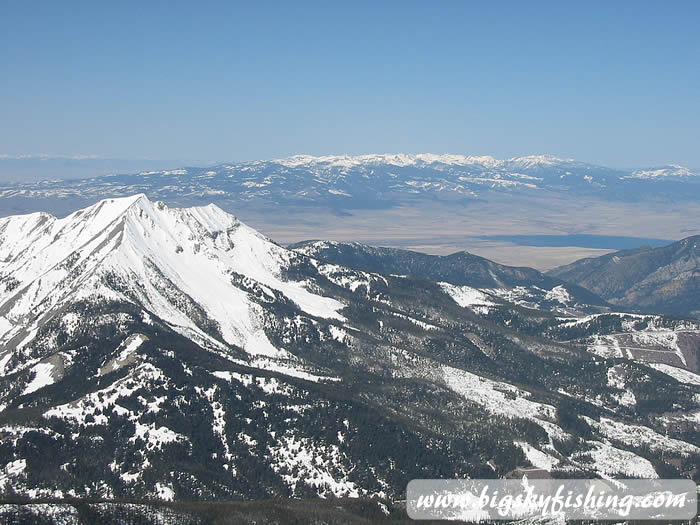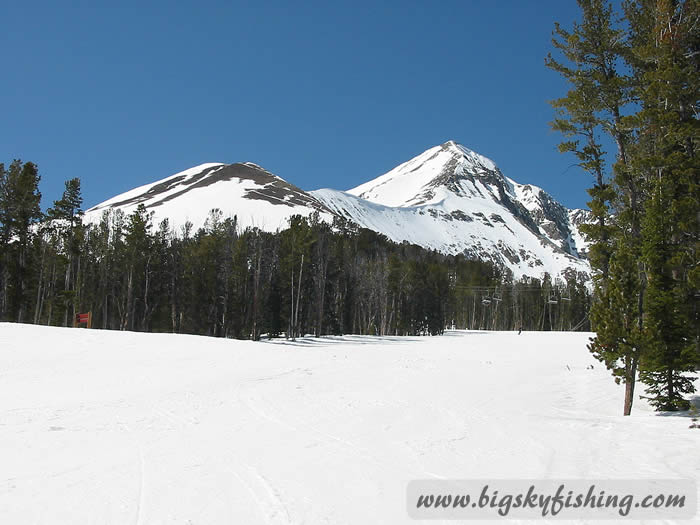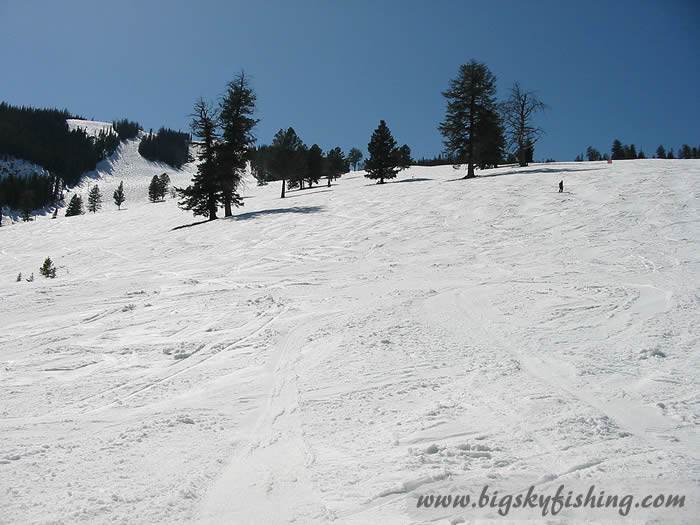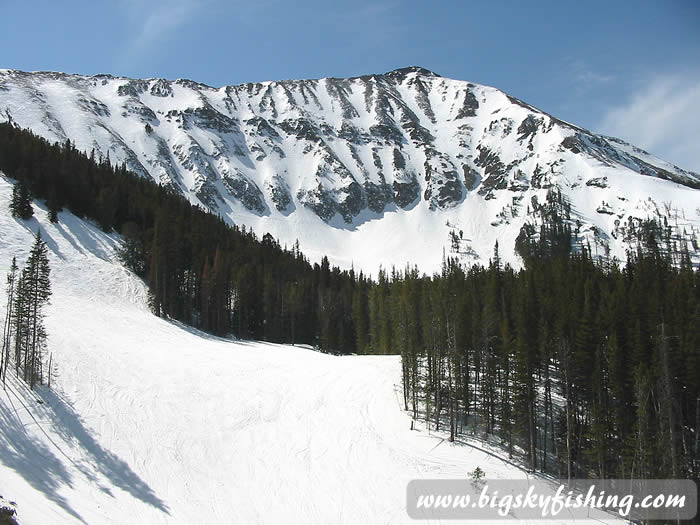Big Sky has the widest variety as well as the most skiing terrain of any ski area in Montana, spread over more than 5700 acres (all of which is skiable, by the way). With the addition of Moonlight Basin in October 2013, Big Sky also became the largest ski resort by acreage in the United States. Big Sky also has more vertical rise than any other Montana ski area – a lofty 4350 feet. Admittedly, this vertical number is stretching things a bit – you can’t ski it all in one run. Instead, a better vertical rise measurement is from the base lodge area (the Mountain Village) to the summit of Lone Peak. Measured this way, the vertical rise at Big Sky is 3650 feet, which is still a very sizable and respectable vertical by any standard.
 |
| View from the Summit of Lone Peak |
Befitting the largest ski area in Montana, Big Sky has the largest lift network in the state with twenty-one chair lifts (five are high-speed quads), one tram and several surface lifts. The tram is used to access the summit of Lone Peak while the surface lifts are scattered around the mountain in the various beginner areas.
Big Sky sits among the Spanish Peaks mountain range. Specifically, the ski area is built on and around a mountain known as Lone Peak, which has a summit elevation of 11,166 feet. Lone Peak is a “skiers mountain” if there ever was one. The top half of Lone Peak has some of the best expert skiing in Montana spread over a huge expanse of wide open terrain. Meanwhile, the lower elevations are flatter but well rounded, allowing for a great variety of intermediate and beginner ski runs.
Big Sky resort is broadly divided into three “sections” for skiing, for lack of a better way to describe it. These different ski sections are the Lone Peak area, the Andesite Mountain area, and the Moonlight Basin area. A broad overview of each section is provided below.
The Lone Peak Section
 |
| View From the Lone Peak section of Big Sky Resort. |
The widest variety of skiing and the most challenging of terrain is the Lone Peak section. The Lone Peak section consists of all the trails that are built on Lone Peak. The trails on Lone Peak contain everything from well groomed intermediate runs, nice and flat beginner runs, and absolutely dazzling expert and advanced expert trails that drop down steep, narrow chutes.
The most challenging trails on Lone Peak are accessed from the summit of Lone Peak itself. Reaching the summit of Lone Peak is an adventure in and of itself. From the top of the Swift-Current High Speed Quad, skiers will need to drop down into the aptly named “The Bowl” and pick up the Lone Peak Triple Chair, which then ends near the Lone Peak Tram.
The Lone Peak Tram is the only lift that accesses the summit. By design, the tram has a low capacity so as to prevent overcrowding on the rather small summit of Lone Peak. Because of this, lift lines at the Tram can—during busy periods—be rather lengthy.
Despite the lines, I highly recommend taking the tram up to the summit—even if you can’t ski. On a clear day the views from the summit of Lone Peak are among the best in Montana. For those who don’t feel like taking their chances on the advanced and expert trails that lead down from the summit, fear not--you can always take the tram back down.
The Andesite Mountain Section
The majority of skiing at Big Sky is on Lone Peak. However, just to the east of Lone Peak – and rising abruptly out of the Mountain Village Base Area – is Andesite Mountain (summit elevation of 8800 feet).
 |
| One of the many excellent trails on the back side of Andesite Mountain. |
On the front or village side of Andesite Mountain, a skier on top of Andesite Mountain will ski right back down into the Mountain Village area. This side of Andesite Mountain doesn’t have the killer vertical like is found elsewhere at the resort (1160 vertical feet from the top of Andesite Mountain to the village area), but it does have some of the nicest groomed intermediate runs on the mountain. Additionally, since there is no “run off” on the bottom – this vertical measurement is a “true vertical”, not a misleading one. The village side of Andesite Mountain is served by its own High Speed Quad, the Ram Charger Express.
The back side of Andesite Mountain is the east side - or the ski trail that you can see from the road the leads to the resort. A skier who heads down the back side of Andesite Mountain will find an excellent mix of expert and intermediate trails, with a vertical rise measuring 1,728 feet. This side of Andesite Mountain is also served by its own High Speed Quad, the Thunder Wolf Express. In comparison to other areas at Big Sky, the east side of Andesite Mountain is lightly used and is thus a good place to go to escape the crowds when the resort is busy.
Andesite Mountain actually has two backsides, one of which is designed more for beginners. This "second" backside on Andesite Mountain has perfect beginner terrain, with gentle slopes and wide runs. The vertical rise on the back side of Andesite Mountain measures 1256 feet. For beginner skiers looking for some nice terrain well away from the crowds found around the base area, this is the place to come.
The Moonlight Basin Section
 |
| The Headwaters in the Moonlight Basin section of Big Sky |
The Moonlight Basin section of Big Sky Resort is a new addition. In October 2013, Moonlight Basin ski resort became part of Big Sky. This acquisition added more than 1500 acres of new skiing at Big Sky.
The Moonlight Basin section is a lightly used, at least in comparison to other parts of the mountain. Excellent trail variety is also located here, with some superb expert skiing found at the Headwaters while many intermediate trails meander their way through the forested slopes below. And beginners won't be left out, either, as the beginner terrain in the Moonlight Basin section contains some of the nicest trails at Big Sky.
Previous Page Next Page : Photos
